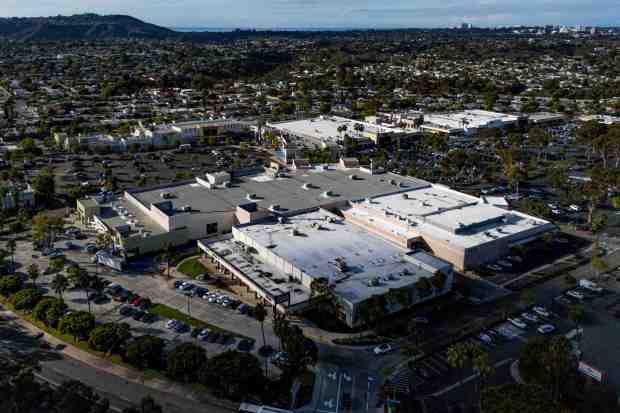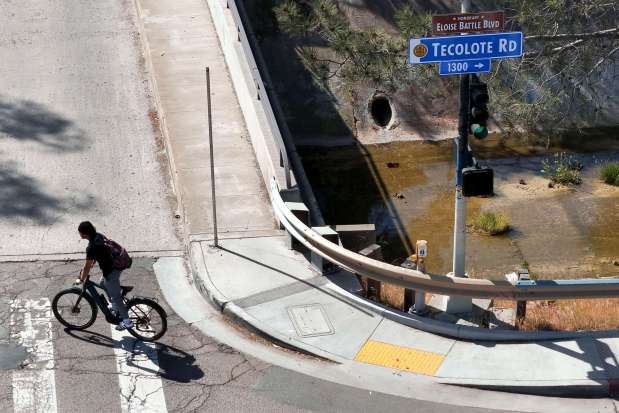An aggressive plan to add nearly 20,000 potential new homes to Clairemont over the next 30 years got a key green light Friday when the City Council’s Land Use and Housing Committee unanimously approved it.
The new growth blueprint for Clairemont — the oldest and largest of San Diego’s suburban neighborhoods — also includes a new fire station, new parks and a possible new trolley station at Jutland Drive and Morena Boulevard.
The blueprint, which could boost the neighborhood’s population from the current 80,000 to about 119,000, also shrinks vehicle lanes on Morena Boulevard and Genesee Avenue to make way for bicycle-only and bus-only lanes.
There are also some ambitious goals like aerial tramways over Interstate 5 to connect Clairemont to coastal areas, and a missing link hiking trail that would connect Marian Bear Park and Tecolote Park.
And the neighborhood’s 30-foot building height limit would be wiped out in many areas to allow high-rise and mid-rise buildings that would range in height from 40 feet to 65 feet.
Despite so many ambitious elements and major changes, the proposal is getting relatively strong support from community leaders as it makes its way toward a final City Council approval scheduled for sometime next month.
That’s likely because it aims to preserve most of Clairemont’s suburban character by concentrating the new housing in existing commercial areas.
Clairemont’s sprawling shopping plazas would be transformed into densely built mixed-use villages with mid-rise housing above the shops. The area’s neighborhoods of single-family homes would remain mostly untouched.
Much of the new housing would also be built along the new trolley line, which runs along Clairemont’s western edge near Morena Boulevard on its way from Old Town to UC San Diego.
City officials say the new growth blueprint would bring a much wider variety of housing to Clairemont, allowing people of all incomes to live in one of the city’s most appealing and prosperous neighborhoods.
Only 1,000 of Clairemont’s 33,300 existing homes are rent-restricted for low-income residents. Many of the 19,500 new homes called for in the plan would be rent-restricted, especially those built along the trolley line.
And more than 90% of the new homes would be built in what are called high-resource areas, places with relatively high numbers of high-paying jobs, educational opportunities and community amenities like parks and libraries.
Councilmembers Raul Campillo and Vivian Moreno cited the large number of new homes in high-resource areas as a key reason they voted Friday to move the new growth blueprint to a full council vote in December.
Moreno also praised the plan, called a community plan update, for concentrating so much housing along the trolley line and for potentially adding so much housing to the city.
“There is a very great need to build more homes in San Diego,” said Moreno, praising the decision to wipe out the Clairemont height limit in many parts of the neighborhood. “We simply cannot continue to be constrained by height limits that are too low, if we want to make sure that future generations of San Diegans have access to the housing that allows them to continue to live where they were raised.”
 The Clairemont Town Square seen on Friday, Nov. 21, 2025 in San Diego. (Meg McLaughlin / The San Diego Union-Tribune)
The Clairemont Town Square seen on Friday, Nov. 21, 2025 in San Diego. (Meg McLaughlin / The San Diego Union-Tribune)
Moreno, however, asked city officials to study concerns raised by the community over plans to designate the city’s Rose Canyon Operations Yard on Morena Boulevard for high-density housing.
Critics, including the Clairemont Town Council and the Clairemont Community Planning Group, say the plan would allow too many homes to be built on the site.
The plan would shift the site’s zoning from industrial to residential and allow buildings as tall as 65 feet. City officials say an industrial designation makes no sense, with more appealing industrial land available in Sorrento Mesa and Kearny Mesa.
Moreno and Campillo said the full council should decide the fate of the Rose Canyon yard, stressing that the council member who represents Clairemont — Jennifer Campbell — couldn’t comment Friday because she isn’t on the Land Use and Housing Committee.
While the community planning group has been mostly supportive, they’ve successfully gotten city officials to make many changes in the blueprint and are still seeking more.
One change they successfully lobbied to add to the proposal was a new trolley stop at Jutland Drive, a street of single-family homes that many people use as a cut-through to a Costco and other businesses on Morena Boulevard.
The city also agreed, in response to resident concerns, to designate 231 acres of canyonlands as private open space to prevent potential development of them.
Matthew Wang, chair of the community planning group, said part of the reason his group has been open-minded is that it understands the blueprint includes things that may not happen.
“We understand that this plan is aspirational, and it’s an opportunity to be bold and visionary,” he said.
Councilmember Kent Lee stressed Friday that typically only a small portion of the new housing units in community plan updates get built during the first few years after the plan is approved — even many years after.
The proposal would update the Clairemont Community Plan for the first time since 1989 — 36 years ago. Clairemont, which was developed in the 1950s, recently celebrated its 75th anniversary.
Wang said he has doubts many of the city’s plans for new recreational amenities will actually happen.
The plan calls for 14 new parks, 22 upgraded parks and three new recreation centers. Late additions to the plan include a rec center at South Clairemont Community Park.
 A sign reads “Eloise Battle Blvd.” along Tecolote Road and Morena Boulevard seen on Wednesday, May 14, 2025, in San Diego. (Meg McLaughlin / The San Diego Union-Tribune)
A sign reads “Eloise Battle Blvd.” along Tecolote Road and Morena Boulevard seen on Wednesday, May 14, 2025, in San Diego. (Meg McLaughlin / The San Diego Union-Tribune)
Another late addition is a plan to extend the proposed Morena Boulevard bike route to include a segment from Knoxville Street to Tecolote Road.
City officials note that developers will be required to build linear parks and paseos as part of the new mixed-use villages. There are also plans for pocket parks and more joint-use parks at local schools.
The new fire station would be southwest of the intersection of Clairemont Drive and Balboa Avenue. The plan also calls for Fire Station 36 in eastern Clairemont possibly to be expanded.
While most community members expressed only minor complaints, one resident of Bay Park in western Clairemont revived an argument about bay views from more than a decade ago when the trolley line was being planned.
“This is an economic disaster for me and every one of my neighbors on the hill,” said Connie Brewer, suggesting that new mid-rise housing blocking her bay view will reduce her property’s value by $1 million. “Most of the single-family homes will lose the enjoyment and the peace derived from a bay view.”
The plan would lift the height limit to 65 feet in some parts of Bay View Village. Other areas slated for 65-foot height limits include the Balboa Avenue trolley station and the neighborhood’s two main shopping areas — the Clairemont Town Square and the sprawling plazas where Balboa and Genesee avenues intersect.
Many housing advocates praised the proposed blueprint Friday, expressing hope it will help solve the local housing crisis.
“New housing mitigates rent increases,” said Manny Rodriguez, president of the YIMBY Democrats of San Diego. “Cities that build a lot more housing have seen rent decreases.”
Clairemont is bounded by Interstate 5 and Pacific Beach to the west, state Route 52 and University City to the north, Linda Vista to the south and Kearny Mesa to the east. It is San Diego’s largest neighborhood geographically, at 11 square miles.
Clairemont’s community plan covers 6,755 acres. By comparison, the community plan for La Jolla, another large neighborhood, covers 5,718 acres.
Details on the proposed plan can be submitted to the city through next Sunday at clairemontplan.org.
